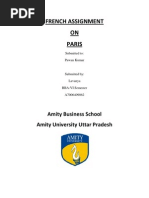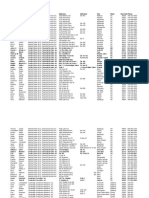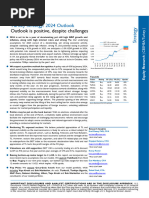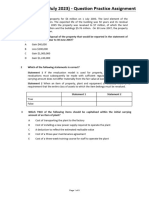Paris: Capital of The Nineteenth Century?
Paris: Capital of The Nineteenth Century?
Uploaded by
Gordon ChanCopyright:
Available Formats
Paris: Capital of The Nineteenth Century?
Paris: Capital of The Nineteenth Century?
Uploaded by
Gordon ChanOriginal Title
Copyright
Available Formats
Share this document
Did you find this document useful?
Is this content inappropriate?
Copyright:
Available Formats
Paris: Capital of The Nineteenth Century?
Paris: Capital of The Nineteenth Century?
Uploaded by
Gordon ChanCopyright:
Available Formats
Paris: capital of the nineteenth century?
11/15/2011 12:05:00 PM
Geometric + Bourgeois logic of Paris. Preliminaries: Walter Benjamin and Paris Post-Revolutionary Paris Second Empire Paris Napoleon and Haussmann Napoleons Paris: Rationales Haussmanns Paris Commodities, spaces and the city Seeing the city: Ville surveillee Ville invisible?
Benjamin: German Marxist intellectual and cultural critic, 1892-1940 Shuttled between major European cities, but especially Berlin and Paris Focus on the city and the techno-culture of modernity. 3 Moments: Influence of Louis Aragons Paris paysan (1926) best book about paris, a micrological/surreal analysis Paris, capital of the nineteenth century (1927) The Arcades Project: Collected material 1927-1940 15,000 notes on the conjunction of nineteenth-century technology and culture in Paris. Archaeologies, fragments and constellations. Seeing Paris A phantasmagoria was a magic lantern that became popular in the early nineteenth century. It used back projection to parade a series of ghostly images before a startled audience who were unaware of their source. The spectral images of commodity culture: Paris as ville invisible? Public works in Paris
Until the early nineteenth century there were few concerted attempts to co-ordinate public works in Paris, and most were embellishments directed towards the edges of the city where land values were low and the costs of intervention could be contained.
Second Empire Paris Proclamation of the Second Republic, 1848 Louis Napoleon 1848 Revolution, bloody reprisals and a financial crash force the abdication of King Louis-Philippe Napoleon took a close personal interest in a Grand Design for Paris His agent was Georges-Eugene Huassmann, Prefet of the department of the Seine (1852-`869) 4Rationales: public health, congestion, security, prestige. 1: Public Health Public alarm over the cholera epidemics of the 1830s and 1840s The epidemic of 1848 killed 19,000 in Paris alone Most doctors believed that cholera was spread through local vectors: Poverty, unsanitary housing, overcrowding and defective sewers. Large scale street clearances were the only practical means of demolishing slum properties and constructing new sewers and water supply systems. 2: Congestion Rapid increase in population: 1801: 500,000 1851: 1,000,000+ Heightened pressure on the inner city: Overcrowding, traffic congestions (exacerbated by railways in 1840s, which accelerated both immigration and industrial and commercial development New avenues and boulevards to permit circulation 3: Security
Insurrection: Since 1789 no government had been safe from the threat of violent overthrow in the streets of Paris Barricades had been erected in Paris nine times in the 25 years before the Second Empire. Militarization of urban space: New thoroughfares: Rapid deployment of military throughout the city Avenues and boulevards too wide to be blockaded 4: Prestige Napoleon here visiting construction of the new Paris Opera with Haussmann wanted to make Paris the most beautiful city in the world the crowning climax to and theatrical setting for the pomp and power of the Second Empire. Haussmans Paris Atttilla of the straight line Haussman spent his first year in office implementing a detailed and systematic survey of Paris to provide the framework for the master-plan which he had drawn up on a scale of 1:5000 and displayed on an easel in his office. Key: 3 networks, Haussmans 3 Routes The first network ripped open the belly of Old Paris In 1856 as many as 14,000 people still lived in this maze of streets, alleys and courts: high incidence of poverty and overcrowding Haussman said he wanted to tear open Old Paris, the districts of riots and barricades, by a wide central thoroughfare which would pierce this almost impenetrable labyrinth from one side to the other. Ile de la Cite Haussmann developed key state institutions already established on the Ile de la Cite, creating a fortress without walls capable of controlling the restless arrondissements on both sides of the river
The second network was concentrated on the Right Bank and the eastern sections of the city. Spaces as commodities: Integration of finance capital and landed property: o Parisian property was more and more appreciated as a pure financial asset, as a form of fictitious capital whose exchange value, integrated into the general circulation of value, entirely dominates use value: David Harvey As its pulverized spaces were commodified, Paris became an increasingly divided city: poor literally marginalized orbiting the wealth in the centre The centre of the city was given over to the conspicuous commodification of social life: The power of money was celebrated as spectacle and display on the grands boulevards, in the grands magasins, in the cafes and at the races, and above all in those spectacular celebrations of the commodity fetish, the expositions universelles David Harvey Exteriors became interiors of the bourgeoisie, while panoramas, dioramas and photography brought the exterior into the interior. The boulevards lit by gas lamps, dazzling shop window displays, cafes open to the street.. became corridors of homage. David Harvey Le Bon Marche Originated as a small shop in 1838 and became a department store in the 1850s, a new building opened in 1867.
11/15/2011 12:05:00 PM
11/15/2011 12:05:00 PM
You might also like
- FCO-SC-PT BINTAN ALUMINA INDONESIADocument19 pagesFCO-SC-PT BINTAN ALUMINA INDONESIAzalviazizNo ratings yet
- Napoleon III and The Rebuild of ParisDocument9 pagesNapoleon III and The Rebuild of ParisJohn M. Renehan100% (4)
- THE CITY - Baron Haussmann and Modern ParisDocument9 pagesTHE CITY - Baron Haussmann and Modern Parisviki_delancerNo ratings yet
- Paris in Simple English!Document2 pagesParis in Simple English!solcito_ceballosNo ratings yet
- How Paris Became Paris: The Invention of the Modern CityFrom EverandHow Paris Became Paris: The Invention of the Modern CityRating: 4 out of 5 stars4/5 (61)
- 7W580 19th Century TheoryDocument94 pages7W580 19th Century Theoryvoicu_man100% (1)
- The Contemporary World: Quarter 1: Week 1Document20 pagesThe Contemporary World: Quarter 1: Week 1Kiermorales100% (1)
- Account Summary Payment Information: New Balance $1,102.59Document6 pagesAccount Summary Payment Information: New Balance $1,102.59Nhan NguyenNo ratings yet
- Haussmann ParisDocument28 pagesHaussmann ParisDaiana Andronache0% (1)
- Napoléon I: FlâneursDocument2 pagesNapoléon I: FlâneursShreya MarwahaNo ratings yet
- Hist 211 10-5Document89 pagesHist 211 10-5Juno IantoNo ratings yet
- George HaussmannDocument42 pagesGeorge HaussmannTess AustriaNo ratings yet
- Blaszkiewicz 2020 - Listening To The Old City JM ArticleDocument35 pagesBlaszkiewicz 2020 - Listening To The Old City JM ArticleJack Blaszkiewicz100% (1)
- Washington D.C & Paris: History of Town PlanningDocument38 pagesWashington D.C & Paris: History of Town PlanningIoana SpirescuNo ratings yet
- French AssignmentDocument34 pagesFrench AssignmentUtkarsh ShuklaNo ratings yet
- articleinsiderDocument7 pagesarticleinsiderMariaNo ratings yet
- ParisDocument9 pagesParisPiyali RoyNo ratings yet
- Baron HaussmannDocument22 pagesBaron Haussmanntanie100% (2)
- Colegio Continental: Name: Nathalia Negrin Vargas 10th Grade Teacher: Ms. Jael PérezDocument12 pagesColegio Continental: Name: Nathalia Negrin Vargas 10th Grade Teacher: Ms. Jael PérezWilliam worchi Bobea GomezNo ratings yet
- Soppelsa (2009) : The Fragility of Modernity - Infrastructure and Everyday Life in Paris 1870-1914Document459 pagesSoppelsa (2009) : The Fragility of Modernity - Infrastructure and Everyday Life in Paris 1870-1914exddidrl2768No ratings yet
- The Sinking of Marseille: Alèssi Dell'umbriaDocument19 pagesThe Sinking of Marseille: Alèssi Dell'umbriaRojonegroNo ratings yet
- Eric Mumford - Designing The Modern City. Urbanism Since 1850Document39 pagesEric Mumford - Designing The Modern City. Urbanism Since 1850Daniela Andreea PredaNo ratings yet
- Paris: FranceDocument39 pagesParis: FranceAlex LeeNo ratings yet
- ParisDocument2 pagesParisardayNo ratings yet
- Chagnan Burke_rue lafitteDocument25 pagesChagnan Burke_rue lafitteyagmurNo ratings yet
- The City and The GrassrootsDocument23 pagesThe City and The GrassrootsTheCanadiaFreeTraderNo ratings yet
- French Operetta Offenbach and CompanyDocument15 pagesFrench Operetta Offenbach and CompanyDiógenes MacielNo ratings yet
- Paris in The Belle PoqueDocument41 pagesParis in The Belle PoqueBuddyNo ratings yet
- Self Work in EnglishDocument6 pagesSelf Work in EnglishFatyaNo ratings yet
- Belle Époque: Popular Culture and FashionsDocument8 pagesBelle Époque: Popular Culture and FashionsDario Deva100% (1)
- París.Document2 pagesParís.teresasd99No ratings yet
- World CitiesDocument26 pagesWorld CitiesAnarchivistaNo ratings yet
- Walter Benjamin - Haussmann or The BarricadesDocument2 pagesWalter Benjamin - Haussmann or The BarricadesAndrea FacchettiNo ratings yet
- Ch6 France 16th To 18th CenturyDocument30 pagesCh6 France 16th To 18th CenturyJeremyNo ratings yet
- ParisDocument1 pageParisCristi AlexNo ratings yet
- Notes MSD501Report TheGrandCityDesignDocument15 pagesNotes MSD501Report TheGrandCityDesignMaria Belinda CampanaNo ratings yet
- Industrial revolution and hausmans renovation of paris.pptxDocument44 pagesIndustrial revolution and hausmans renovation of paris.pptxShathvika SatheeshNo ratings yet
- Benjamin 1939 ExposeDocument13 pagesBenjamin 1939 ExposeAnonymous T51rWiNJNo ratings yet
- Paris Reborn: Napoléon III, Baron Haussmann, and the Quest to Build a Modern CityFrom EverandParis Reborn: Napoléon III, Baron Haussmann, and the Quest to Build a Modern CityRating: 4 out of 5 stars4/5 (10)
- Urban Theorist & Brief History PDFDocument10 pagesUrban Theorist & Brief History PDFNerissa SantiagoNo ratings yet
- Document 31Document2 pagesDocument 31SyedMuhammad AfnanNo ratings yet
- The City of ParisDocument23 pagesThe City of ParisMARÍA BARRIO SÁNCHEZ100% (1)
- 4828 19924 Evolution of Human SettlementsDocument20 pages4828 19924 Evolution of Human SettlementsShikha Verma0% (1)
- Urban SociologyDocument3 pagesUrban SociologyitaintjusuNo ratings yet
- 18th and 19th Century EuropeDocument9 pages18th and 19th Century EuropeArce RostumNo ratings yet
- mODULE 3 - Urban & Regional PlanningDocument59 pagesmODULE 3 - Urban & Regional PlanningRANILENo ratings yet
- Rise of The Idea of ExpositionsDocument20 pagesRise of The Idea of Expositionsrajat charayaNo ratings yet
- KAM Daumier Paris PDFDocument20 pagesKAM Daumier Paris PDFFernanda_Pitta_5021100% (1)
- Paris: This Article Is About The Capital City of France. For Other Uses, SeeDocument7 pagesParis: This Article Is About The Capital City of France. For Other Uses, SeeBikram92No ratings yet
- The Golden Age of Late Medieval CitiesDocument6 pagesThe Golden Age of Late Medieval CitiesThomasHubertNo ratings yet
- Paris-in-the-Twentieth-Century-jules-verneDocument148 pagesParis-in-the-Twentieth-Century-jules-verneJoe CNo ratings yet
- History of A CityDocument100 pagesHistory of A CityWendell Marc TamaniNo ratings yet
- Thesocialistminority Andtheparis Communeof1871 A Unique Episode in The History of Class StrugglesDocument57 pagesThesocialistminority Andtheparis Communeof1871 A Unique Episode in The History of Class StrugglesKateNo ratings yet
- ARC LECTURE 3-Metropolis Fritz Lang 1927 - Video: Meaning of Term ModernDocument4 pagesARC LECTURE 3-Metropolis Fritz Lang 1927 - Video: Meaning of Term ModernShubh2993No ratings yet
- Art History II v1Document809 pagesArt History II v1Helene Elena86% (7)
- Pipex Price List 01-2021Document5 pagesPipex Price List 01-2021ahmed.elkady1No ratings yet
- Coal Priviatisation DisivestmentDocument10 pagesCoal Priviatisation DisivestmenttariqNo ratings yet
- Economicproject 220513142118 58e4c686Document37 pagesEconomicproject 220513142118 58e4c686Chandrima MannaNo ratings yet
- Money LaunderingDocument5 pagesMoney LaunderingArslan SajjadNo ratings yet
- Cambridge International As Amp A Level Chemistry Workbook With Digital Access 2 Years 3nbsped 1108859054 9781108859059Document3 pagesCambridge International As Amp A Level Chemistry Workbook With Digital Access 2 Years 3nbsped 1108859054 9781108859059Wally WestNo ratings yet
- SJK (C) Chung Hwa I-000632 Do-000303Document2 pagesSJK (C) Chung Hwa I-000632 Do-000303LAM CHUI YONG MoeNo ratings yet
- RKIPL-WMS 02 - Polyurethane Painting WorkDocument10 pagesRKIPL-WMS 02 - Polyurethane Painting Workvivekwagh09No ratings yet
- Informal Sector in BangladeshDocument11 pagesInformal Sector in Bangladeshshoaiburrahman958No ratings yet
- Business Economics AssignmentDocument14 pagesBusiness Economics AssignmentShivankar sukulNo ratings yet
- Mineral-Resources of AlbaniaDocument38 pagesMineral-Resources of AlbaniaconradaldertonNo ratings yet
- Econ 101: Principles of Microeconomics Fall 2012: Problem 1: Use The Following Graph To Answer The QuestionsDocument3 pagesEcon 101: Principles of Microeconomics Fall 2012: Problem 1: Use The Following Graph To Answer The QuestionswwongvgNo ratings yet
- Economies 10 00294Document14 pagesEconomies 10 00294k60.2112450026No ratings yet
- WWW Cryptominerbros Com Product Bitmain Antminer l7 9 5gh SDocument8 pagesWWW Cryptominerbros Com Product Bitmain Antminer l7 9 5gh ScryptominerbrosNo ratings yet
- Could The Textile Industry Help Economy To GrowDocument10 pagesCould The Textile Industry Help Economy To GrowMostafa SarhanNo ratings yet
- Amanda Wadsworth Call ListDocument14 pagesAmanda Wadsworth Call ListjdhaireNo ratings yet
- Acc 204 Accounting For Overhead by GuererroDocument9 pagesAcc 204 Accounting For Overhead by GuererroJuan FrivaldoNo ratings yet
- Unlu Strategy Jan2024Document74 pagesUnlu Strategy Jan2024f7wczmr665No ratings yet
- Essay For YanaDocument3 pagesEssay For YanaYana YatsenkoNo ratings yet
- SS107 Group 4 (Urban Planning)Document18 pagesSS107 Group 4 (Urban Planning)PEFANIO, CHRIS JERICHO D.No ratings yet
- Ua 10 Pa 5016Document3 pagesUa 10 Pa 5016PUNALE MICHEL REDDYNo ratings yet
- Document 1516 3664Document68 pagesDocument 1516 3664rubyhien46tasNo ratings yet
- Trading Checklist (2024) PDFDocument2 pagesTrading Checklist (2024) PDFDJ BuzzyB Official100% (1)
- Types of MoneyDocument4 pagesTypes of MoneyAlexandraNo ratings yet
- The A.B Furniture Dining Table Designs - 20240217 - 034342 - 0000.pdf - 20240217 - 105458 - 0000Document47 pagesThe A.B Furniture Dining Table Designs - 20240217 - 034342 - 0000.pdf - 20240217 - 105458 - 0000ZehraFarhanNo ratings yet
- 39 Banking Awareness History of Banking in IndiaDocument5 pages39 Banking Awareness History of Banking in IndiasukutraoNo ratings yet
- EC311 - Trade Theories 4 EditedDocument80 pagesEC311 - Trade Theories 4 EditedVicky KhanNo ratings yet
- Irmaya Safitra - FR Session 1 Practice Assignment - Questions (8th July 2023)Document5 pagesIrmaya Safitra - FR Session 1 Practice Assignment - Questions (8th July 2023)irmaya.safitraNo ratings yet

























































































